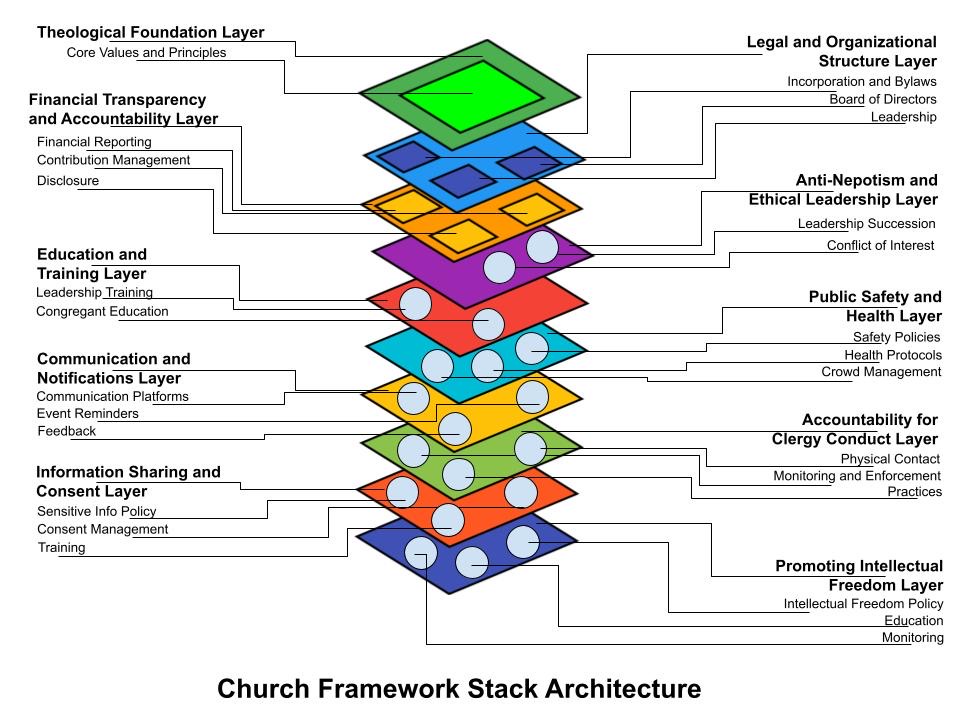Framework Architecture:
1. Theological Foundation Layer
Core Values and Principles
- Define and communicate the church’s core theological values and principles that guide governance.
- Reference key scriptural passages that emphasize transparency, accountability, and servant leadership.
2. Legal and Organizational Structure Layer
Incorporation and Bylaws
- Ensure legal incorporation as a non-profit organization.
- Develop clear bylaws and governance structures.
Board of Directors
- Establish a diverse and independent board to oversee operations and financial management.
- Define roles and responsibilities of board members.
Leadership Roles and Responsibilities
- Clearly outline the roles and responsibilities of clergy, staff, and lay leaders.
- Prevent concentration of power and ensure checks and balances.
3. Financial Transparency and Accountability Layer
Financial Reporting
- Implement strict financial reporting requirements and regular audits by independent third parties.
Contribution Management
- Set up transparent systems for managing and allocating contributions.
Public Disclosure
- Make financial reports and key decisions publicly available to congregants and stakeholders.
4. Anti-Nepotism and Ethical Leadership Layer
Leadership Succession
- Create clear policies for leadership succession to prevent nepotism.
- Implement a democratic selection process for leadership roles.
Conflict of Interest
- Develop and enforce a conflict-of-interest policy.
New Church Planter Security Deposits
- Security Deposit Requirement: New church planters must deposit a security deposit to ensure ethical conduct and financial responsibility.
5. Education and Training Layer
Leadership Training
- Provide ongoing training for clergy and leaders on ethical leadership, financial management, and organizational governance.
Congregant Education
- Educate congregants on their rights and responsibilities within the church.
6. Public Safety and Health Layer
Safety Policies and Procedures
- Develop emergency plans and train staff and volunteers.
- Install security cameras and set up first aid stations.
Health Protocols
- Install hygiene stations and implement regular cleaning routines.
- Conduct health screenings during outbreaks or pandemics.
Crowd Management
- Set capacity limits and use ticketing systems to manage attendance.
7. Communication and Notifications Layer
Communication Platforms
- Adhere to communicating key service/gathering theme
- Use multiple channels (emails, SMS, push notifications) for communication.
Event Reminders and Updates
- Send regular reminders and updates about upcoming events and safety protocols.
Feedback Mechanisms
- Implement systems for collecting and managing congregant feedback.
8. Accountability for Clergy Conduct Layer
Appropriate Physical Contact
- Develop a policy on appropriate physical contact and require consent.
- Provide training on alternative spiritual practices.
Monitoring and Enforcement
- Implement anonymous reporting mechanisms.
- Establish an oversight committee to handle complaints.
Preventing Manipulative Practices
- Establish doctrinal guidelines prohibiting manipulative practices.
- Implement strict policies against substance use for manipulation.
Manipulation Using Prophecy and Dreams
- Policy on Prophetic Practices: Develop clear guidelines on the use of prophecy and dreams within the church, emphasizing ethical and responsible use.
- Training and Education: Provide clergy with training on the ethical implications and appropriate use of prophecy and dreams.
- Reporting and Accountability: Establish mechanisms for congregants to report concerns or abuses related to prophecy and dreams.
- Oversight and Enforcement: Create an oversight committee to review and address reported abuses, ensuring accountability and transparency.
9. Information Sharing and Consent Layer
Sensitive Information Policy
- Develop policies for sharing sensitive information with external spiritual practitioners.
- Require explicit consent from congregants.
Consent Management
- Ensure informed consent and provide a process for revoking consent.
Training and Awareness
- Train clergy on ethical information sharing.
- Educate congregants on their rights.
10. Promoting Intellectual Freedom Layer
Intellectual Freedom Policy
- Draft a policy promoting intellectual freedom and barring clergy from discouraging reading diverse materials.
Education and Training
- Conduct workshops for clergy on intellectual freedom.
- Provide information sessions for congregants.
Monitoring and Enforcement
- Implement feedback systems and regular surveys.
- Enforce disciplinary actions for non-compliance.
Promoting Openness
- Organize book clubs and interfaith panels to encourage diverse reading and open dialogue.
